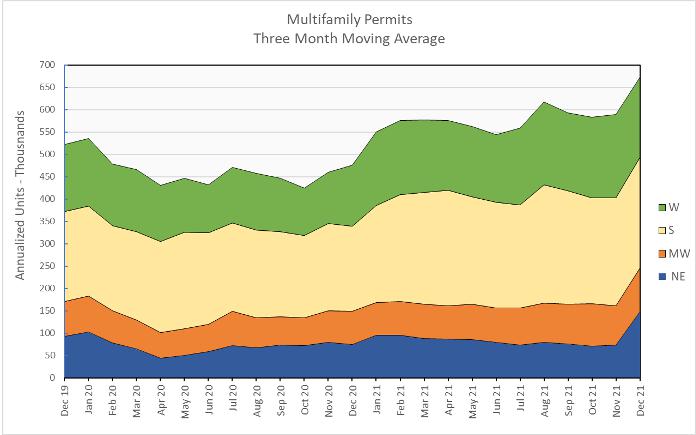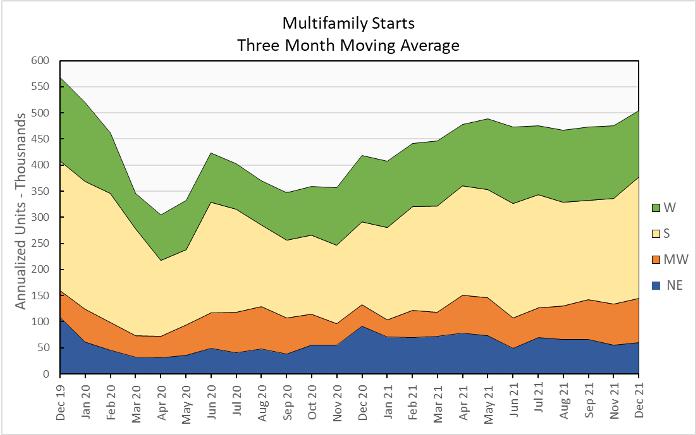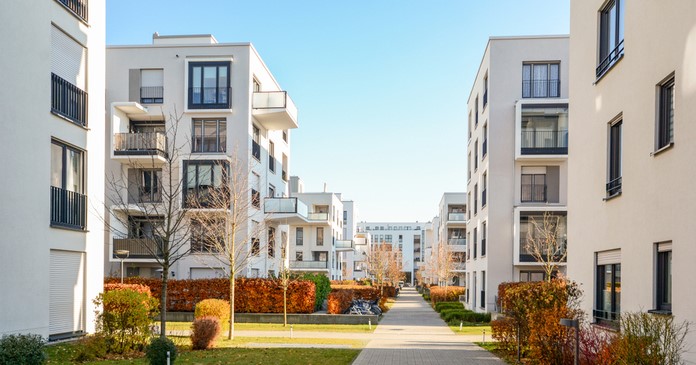The Census Bureau’s new residential construction report for December showed mixed results for multifamily housing construction activity with higher starts but lower completions. Permits were affected by a one-time event and so their results are impossible to compare with recent data.
Multifamily housing permits up significantly
The number of permits issued for buildings with 5 or more units in December was reported to be 675,000 units on a seasonally adjusted, annualized basis. This was up 20 percent (112,000 units) from November’s revised (+3,000 units) figure. December permits were up 42 percent from the level recorded in December 2020 and were up 29 percent compared to the trailing 12-month average.
The Census report included an explanatory note stating that tax law changes in Philadelphia which apply to projects permitted after December 31, 2021 likely caused an increase in permit applications in December. This may partially explain the surge in permit numbers for the Northeast region in this report. If this is the case, it may be some time before these permits translate into starts and we should expect permit numbers to fall next month.
In addition, 70,000 permits were issued in December for units in buildings with 2 to 4 units. This was up 46 percent (22,000 units) from the revised level (-1,000 units) for November. December permits for units in buildings with 2 to 4 units were up 43 percent from the year-ago level and up 38 percent compared to the trailing 12-month average.
Regional data for multifamily housing is only reported for structures with two or more units. “Structures with 5 or more units” is not broken out as a separate category. Since the regional data is highly volatile and is frequently revised, it is examined here based on three-month moving averages. This averaging will tend to smooth out the month-to-month variations in the data.
Nationally, the three-month weighted moving average for permits issued for multifamily housing in December was up 14 percent from the level in November and was 41 percent higher than the level of December 2020. Permit issuance history is shown in the first chart, below. The three-month weighted moving average for permits came it at 673,000 units.
On a month-over-month basis, the three-month weighted moving average for permit issuance was up 101 percent in the Northeast. Perhaps better reflecting the state of the multifamily construction market, permits were up 11 percent in the Midwest and 3 percent in the South but were down 4 percent in the West.
When compared to year-earlier levels, the three-month weighted moving average of permits issued was up 99 percent in the Northeast, 31 percent in the West and South, and 30 percent in the Midwest.
The following chart shows the three-month weighted moving averages of permits by region for the last 25 months.

Multifamily housing construction starts rise
The preliminary December figure for multifamily housing starts in buildings with 5 or more units was 524,000 units on a seasonally adjusted, annualized basis. This was reported to be up 14 percent (63,000 units) from the revised figure for November, but half of this apparent increase was due to November’s preliminary starts figure being revised downward by 30,000 units. The reported starts figure was the highest since January 2020.
Compared to December 2020, multifamily housing starts in buildings with 5 or more units was up 56 percent. The preliminary starts figure reported for December 2021 was 18 percent above the trailing 12-month average and 34 percent above the monthly average for 2019.
Multifamily housing construction starts (two or more units per building) in December were up 6 percent from their November level for the country as-a-whole, based on three-month weighted moving averages. Starts were up 15 percent in the South, 10 percent in the Northeast and 7 percent in the Midwest from the levels of the prior month. However, starts were down 9 percent in the West.
The three-month weighted moving average of starts was up 42 percent for the country-as-a-whole on a year-over-year basis. Compared to December 2020, starts were up 106 percent in the Midwest and 47 percent in the South. Starts fell 1 percent in the West and 34 percent in the Northeast.
The following chart shows the starts by region for the last 25 months.

Multifamily housing completions fall
The preliminary December multifamily housing unit completions figure in buildings with 5 or more units per building was 299,000 units on a seasonally adjusted, annualized basis. This was reported to be down 34 percent (156,000 units) from November’s revised figure. However, November’s preliminary figure was revised upward by an exceptionally large 91,000 units, accounting for the majority of the apparent change.
Compared to December 2020, multifamily housing completions in buildings with 5 or more units per building were down 28 percent. Compared to the trailing 12-month average, completions were down 20 percent and compared to the monthly average for 2019, completions were down 14 percent.
For the country as-a-whole, multifamily housing construction completions (two or more units per building) were down 7 percent month-over-month, comparing three-month weighted moving averages. The three-month weighted moving averages of completions was down in all regions, falling 18 percent in the West, 8 percent in the Northeast, and 3 percent in the South and the Midwest.
On a year-over-year basis, the three-month weighted moving average of completions in buildings with 2 or more units per building was down 10 percent nationally. Completions were up 45 percent in the Midwest and 2 percent in the Northeast. Completions fell 7 percent in both the South and 41 percent in the West.
Completions by region for the past 25 months are shown in the chart below.

All data quoted are based on seasonally adjusted results and are subject to revision.












